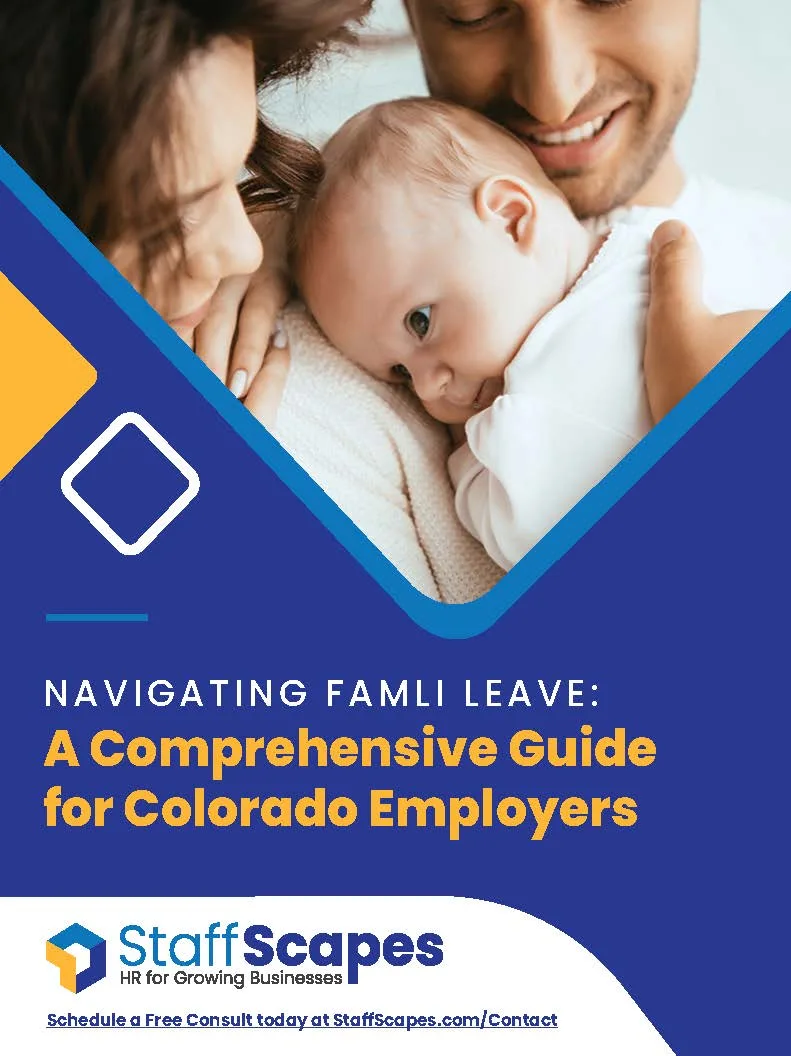The Complete Guide to FAMLI in Colorado
Benefits for Colorado Employers and Employees
Providing comprehensive support for employees and their families, the Family and Medical Leave Insurance (FAMLI) program in Colorado has revolutionized the concept of paid leave. If you’re seeking clarity on how FAMLI can benefit you, or if you’re an employer looking to understand your obligations, you’ve found the right resource.
Discover our carefully curated FAQs about FAMLI in Colorado and download our free guide and checklists for employers on understanding and implementing FAMLI in your organization.

Frequently Asked Questions About FAMLI
General FAQs About FAMLI
Q: Who pays the wages for the employee while they are on leave?
A: The state of Colorado will pay up to 90% of the employee’s weekly wages while they are on leave, but it is capped at $1,100.00 per week. The employer can supplement the remaining percentage of wages with accrued PTO or Sick hours if agreed upon by the employee. The employee can also submit a Short-Term Disability claim if they qualify and are elected into the benefit which can supplement the remaining wages.
Q: Who is considered a “covered individual”?
A: A covered individual is any person who earned at least $2,500 in wages over a period of a year. Employees who have worked a minimum of six (6) months with the employer will qualify for job-protected FAMLI leave.
General FAQs About FAMLI
Q: Who pays the wages for the employee while they are on leave?
A: The state of Colorado will pay up to 90% of the employee’s weekly wages while they are on leave, but it is capped at $1,100.00 per week. The employer can supplement the remaining percentage of wages with accrued PTO or Sick hours if agreed upon by the employee. The employee can also submit a Short-Term Disability claim if they qualify and are elected into the benefit which can supplement the remaining wages.
Q: Who is considered a “covered individual”?
A: A covered individual is any person who earned at least $2,500 in wages over a period of a year. Employees who have worked a minimum of six (6) months with the employer will qualify for job-protected FAMLI leave.
Q: What are the reasons an employee can take FAMLI leave benefits for?
A: The qualifying reasons for leave are as follows:
- Caring for a child within the first year following their birth, adoption, or foster care placement
- Assisting a family member facing a significant health condition
- Managing one’s own serious health condition
- Organizing for a family member’s military deployment
- Securing safe housing, care, and/or legal aid in response to intimate partner violence, stalking, sexual assault, or sexual abuse
A: Covered employees are entitled to up to 12 weeks of paid family and medical leave per year. Individuals with serious health conditions caused by pregnancy complications or childbirth complications are entitled to up to 4 more weeks of paid leave per year for a total of 16 weeks. FAMLI benefits can only be taken once a year across a rolling annual calendar year.
A: The employer does not have the authority to approve or deny FAMLI leave. The Division of Family and Medical Leave Insurance is the only agency that has the authority to approve or deny leave requests.
A: FAMLI definition of ‘Family members’ is as follows:
- Regardless of age, a biological, adopted or foster child, stepchild or legal ward, a child of a domestic partner, a child to whom the covered individual stands in loco parentis, or a person to whom the covered individual stood in loco parentis when the person was a minor.
- A biological, adoptive or foster parent, stepparent or legal guardian of a covered individual or covered individual spouse or domestic partner or a person who stood in loco parentis when the covered individual or covered individual’s spouse or domestic partner was a minor child.
- A person to whom the covered individual is legally married under the laws of any state, or a domestic partner of a covered individual as defined in section 24-50-603(6.5);
- A grandparent, grandchild or sibling (whether a biological, foster, adoptive or step relationship) of the covered individual or covered individual’s spouse or domestic partner; or
- As shown by the covered individual, any other individual with whom the covered individual has a significant personal bond that is or is like a family relationship, regardless of biological or legal relationship.
A: FMLA benefits will run concurrently with FAMLI benefits. Employers are still required to issue documents that are required by the FMLA. If you are a current StaffScapes client, please continue to inform our team if your employees go on leave for any reason.
If you are in need of help understanding how to prepare for FAMLI, reach out to StaffScapes to discuss your disciplinary policies, hiring practices, updating your handbook, and conducting performance reviews.
FAQ’s About Preparing for FAMLI
A: Employers should add a policy to their Employee Handbooks about FAMLI. In this policy, there should be an overview of what FAMLI is as well as a section that states the expectations on how employees are to notify employers about their intent to utilize FAMLI benefits. Employers should also include a follow-up policy for employees who may need additional leave or a leave of absence after they exhaust their FAMLI benefits.
A: Employees in a supervisory or managerial position need to be well-versed in company policies and procedures. Supervisors and managers should be able to answer questions regarding the handbook as well as procedural questions. Managers need to know when to discipline employees, what the discipline process is, and when to conduct performance reviews with team members. These performance reviews do not always have to be formal, but they should be documented.
An example of this is when a manager has a chat with one of their team members about how they think they did that week or month, addressing any areas that need improving, checking in to see how their workload is, then typing or writing a quick synopsis of how the conversation went and filing it in the employees’ file. Managers who have employees who are struggling to follow established company policies or who are underperforming should determine whether a performance plan is sufficient to address the issue or if the employee should be terminated immediately.
Updating policies and having managers and supervisors trained on these policies can help mitigate the risk of a retaliation claim if an employee who utilizes FAMLI benefits is terminated.
A: Employees who have worked for the employer for at least 180 days are entitled to return to the same position or an equivalent position upon return from FAMLI leave. One way of filling this position while their employee is on leave is by utilizing a Temp Service. If this is not possible, another option is to have employees cross-trained in each other’s positions beforehand and delegate tasks to temporarily disperse the open positions throughout your organization. If cross-training and delegation are the option you choose, please check on your employees often to ensure they are not being overworked or underappreciated.
FAQ’s About FAMLI During an Employee’s Leave
Q: How do employees file for FAMLI leave?
A: Employees will use the My FAMLI portal to register and apply for FAMLI benefits. They can access the portal here and should apply for benefits 30 days prior to their projected leave date.
Q: How do employers get notified when employees file for FAMLI benefits?
A: Employers should make it an expectation for their employees to tell them directly if they are going to file for FAMLI benefits. This is not required for employees to tell their employer so in cases where the employee does not tell you, a notification will come through on the employer portal (My FAMLI+ Employer). If you work with our team, StaffScapes is the third-party administrator (TPA) on the account, so we will get notified when an employee is filing, and we will contact you.
A: If you choose not to fill the employee’s position temporarily using a temp agency, their duties may momentarily fall to other employees. This can lead to the employees feeling over- worked and under-appreciated. StaffScapes recommends that when you get notified of an employee going on leave, you have a team meeting with anyone who is going to be impacted by the absence. Explain to your team that this is a temporary thing, and that open communication is encouraged. Encourage your employees to voice their concerns so that you are aware if anyone is feeling overwhelmed by their extra duties.
Doing small acts to show your appreciation can also help. These can be as subtle as buying coffee or breakfast for your employees or giving them an extra paid day off. While an employee is on leave, employers have access to vacancy savings due to not having to pay the employee’s wages. Employers may use vacancy savings to provide a bonus or hazard pay for other employees who take on additional work. This is a generous act that will make your employees feel appreciated for doing the extra work. If you have questions about giving bonuses, please contact StaffScapes.
Reminder: do not state any specific reason as to why the person is taking FAMLI leave. This leave is primarily related to medical reasons which should stay at a need-to-know level.
A: FAMLI and FMLA will run concurrently.
If the employee has previously elected into STD or LTD and qualifies to use those benefits, they can use them to supplement the remainder of their wages that FAMLI benefits do not cover. For example, if an employee is receiving 90% of their wages covered by FAMLI and they have STD insurance, they may be able to use STD to cover the remaining 10% of their wages depending on the STD policy terms and conditions.
A: Any portion of the employee’s health insurance benefits you normally cover; you are required to continue. You may choose to require the employee to continue to pay their share of their contribution to these benefits or you, as the employer, can offer to cover their contribution as well while they are on leave. This should be discussed and approved in writing by both parties prior to the employee going on leave.
If you are a StaffScapes client, our benefits team will reach out to the employee to determine whether or not they will be continuing payment for their health benefits.
After FAMLI Leave FAQs
A: In some cases, your employee may choose not to return to work once their FAMLI leave is completed. If this is the case, you are free to fill their position. Please receive a formal resignation from the employee in writing prior to filling their position permanently.
A: It is possible that your employee has been on leave for several months. Apart from discussing the expectations of both the employer and the returning employee, as well as any necessary
accommodations, a crucial aspect of a seamless reintegration process is to ensure a proper handover.
Before the employee went on leave, another employee or a temporary staff member should have received training on the leaving employee’s workload to ensure a smooth transition while the employee is on FAMLI leave. This process should be repeated upon return from leave. The returning employee should be trained and informed about any changes to standard operating procedures (SOPs) or processes, significant projects, etc., before fully taking over their roles again.
A: Employees are not required by law to receive clearance to return to work after taking FAMLI leave. But in some cases, if the illness or injury could affect their ability to safely do their job duties, requiring documentation from a medical provider that states that the employee is able to return to work with or without restrictions is encouraged for liability purposes.
Please keep open communication between you and your employees throughout their FAMLI leave. We recommend notifying your employee prior to their leave ending that you will be requiring a return to work notice from their medical provider, so they have ample time to request this.
A: Certain illnesses or injuries may require a medical accommodation. If your employee is returning from FAMLI leave and either you or the employee have concerns about them being able to complete the employee’s duties as assigned due to their illness or injury, it is the employer’s responsibility to offer an accommodation.
A: The FAMLI benefit can only be taken once a year across a rolling annual calendar year totaling 12 weeks or up to 16 weeks for individuals who are experiencing pregnancy and childbirth complications.



